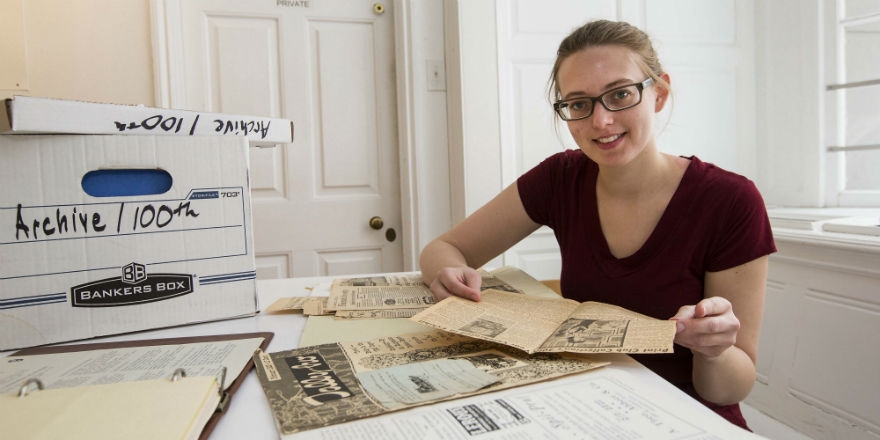Public-history partnership leads to full-time work for Temple graduate

Seth Bruggeman, director of Temple’s Center for Public History, has long seen Philadelphia as a living, vibrant classroom. He has sent his students to study at the Eastern Penitentiary Prison and brought a roaming, interactive museum to the Philadelphia neighborhood of Kensington. Now, he is collaborating with the Print Center—an art gallery and education center in Rittenhouse Square—to offer an internship and a full-time job to Mary O’Neill, a graduate student of public history.
Founded in 1915, the Print Center showcases print and photography exhibitions, and examines the changing role print and photography have played throughout history.
“The Print Center contacted me about the possibility of involving a student in developing exhibits and programming surrounding its 100th anniversary celebration,” Bruggeman said. “We used a tuition waiver to recruit Mary O’Neill, a stellar applicant with a background in the visual arts. It occurred to me that Mary might be willing to tailor her master’s thesis project to the Print Center’s needs if we could offer something special in return. What is more special these days than a job?”
O’Neill’s internship commences this summer, when she will sift through the city’s archives and help assemble collections for display. Her work with the Print Center will be exhibited for its centennial celebration next year. O’Neill’s background in the visual arts and anthropology will help her bring the past century in Philadelphia history to life through the art she discovers tucked away in the archives.
“These are boxes no one has gone through before,” O’Neill said. “Meeting minutes, correspondences, letters; I’ll be sorting through them all.” As she leafs through the material, she will be looking for artifacts that connect the Print Center’s history with the larger art world.
“I don’t know of any other public-history programs that offer a more reliable route to postgraduate employment,” Bruggeman said. “It’s a model that makes perfect sense in Philadelphia, a city whose public historical resources—including museums, archives and historic sites—are unparalleled in scope and quality. It also makes sense for a public-history program that prides itself on training dedicated historians with a passion for community engagement.”
While O’Neill’s job is guaranteed, there are a few conditions attached: She must complete her program of study successfully in order for the Print Center to offer her the position. And though her first year of employment is guaranteed, anything longer than a year depends on the funding the Print Center has available.
“At a minimum, we expect that Mary will serve for roughly a year in the capacity of a project manager, a typical entry-level position for public-history graduates and a great way to begin building a résumé,” Bruggeman said.
O’Neill’s position also furthers the Print Center’s mission to highlight the importance of both printmaking and photography and further appreciation of those media.
“In addition to telling a valuable historical story about Philadelphia, the scope of the center’s anniversary celebration will continue to raise Philadelphia’s profile as an art destination,” said Elizabeth Spungen, executive director of the Print Center. “Hopefully, it will launch us to places we haven’t imagined yet.”
-- Anna Goldfarb, SMC ’08